A fire of freedom and democracy kindled with flesh
An epic poem not yet finished:
Twelve years after Cheng Nan-jung's self-immolation
Hu Hui-lin/Secretary General, Dr. Chen Wen-chen Memorial
Foundation
In the days when expression of
political views was banned, he was a second-generation mainlander who advocated
Taiwan Independence
Cheng Nan-jung's father
came from Fuzhou in China, his mother was from Keelung. Known as a "second
generation mainlander," he was born in Hankou Street in Taipei on
September 12, 1947, before he was born, he almost became one of the
"unlucky ghosts." The most disastrous massacre in Taiwan's recent
history branded its stamp on him as he lay in his mother's womb, and marked the
direction his life was to take.
Later, on his first job-seeking resume, Cheng Nan-jung was to write: "I was born the year of the 228 Incident, and this incident has tormented me throughout my life...Only because we were protected by our neighbors were we mainlanders safe from the wave of retaliation from the Taiwanese." From childhood he thought deeply about this question, and he freely recorded the period of White Terror in the documents he wrote about his life. Later on, because of this experience, he became involved in politics, stirred up agitation and sought freedom of speech, became an open advocate of Taiwan Independence, and thought nothing of dying for his beliefs.
Cheng Nan-jung graduated from Ilan Middle School and Chien Kuo High School. He enrolled successively at National Cheng Kung University's college of engineering, Fu Jen Catholic University's philosophy department and National Taiwan University's philosophy department. He boasted that he was "a first-rate activist thinker, so why should I be a third-rate engineer?" He refused to take the classes on Sun Yat-sen Thought, and handed back his Taiwan University graduation certificate. He said "I'm a first-rate-ist, I don't understand life, and I find this very hard indeed."
Later, on his first job-seeking resume, Cheng Nan-jung was to write: "I was born the year of the 228 Incident, and this incident has tormented me throughout my life...Only because we were protected by our neighbors were we mainlanders safe from the wave of retaliation from the Taiwanese." From childhood he thought deeply about this question, and he freely recorded the period of White Terror in the documents he wrote about his life. Later on, because of this experience, he became involved in politics, stirred up agitation and sought freedom of speech, became an open advocate of Taiwan Independence, and thought nothing of dying for his beliefs.
Cheng Nan-jung graduated from Ilan Middle School and Chien Kuo High School. He enrolled successively at National Cheng Kung University's college of engineering, Fu Jen Catholic University's philosophy department and National Taiwan University's philosophy department. He boasted that he was "a first-rate activist thinker, so why should I be a third-rate engineer?" He refused to take the classes on Sun Yat-sen Thought, and handed back his Taiwan University graduation certificate. He said "I'm a first-rate-ist, I don't understand life, and I find this very hard indeed."
After leaving Taiwan University, he became aware that he had become a completely new person. He said "I was profoundly affected by the phenomenon of injustice in Taiwan, and I made an unequivocal resolution to be true to the ideas of Taiwanization.
In February 1972, Cheng Nan-jung married Yeh Chu-lan, who had been a fellow student at Fu Jen. He was demobbed in October that year, and went into business. He was bent on producing a magazine, and he said: "For a deep and disciplined a thinker like me, producing a magazine is the best way to put my beliefs into practice."
Combining the two
battlefields of journalism and activism, and breaking the four great taboos of
the authorities
In March 1984, he founded Freedom Era Weekly, and boasted that "[it was] fighting for 100 percent freedom of speech." Cheng Nan-jung registered 18 different magazine licenses, as "spare tires" for use when the KMT banned the magazine and suspended publication. He said "I'm not scared of arrest nor of being killed, basically, I'll fight them to the very end."
Freedom Era Weekly ran for five years and eight months, and 302 issues. It only folded six months after Cheng's death. During that time, at the end of 1984, after the Henry Liu murder, the magazine printed Liu's Biography of Chiang Ching-kuo, made public Chiang Ching Kuo's medical condition on many occasions, exposed the shady dealings and abuses of the military, broke through the deified authority of the Chiang family and put pressure on the interference of the military in politics. As a result, the magazine was suppressed and publication suspended a record-breaking number of times. On June 2, 1986, Cheng Nan-jung was framed, and arrested without sentence. His crime was "violating the Public Officials Election and Recall Law," but actually, apart from fighting for freedom of speech, Cheng was continually declaring war on political taboos with his organization of street activism.
In March 1984, he founded Freedom Era Weekly, and boasted that "[it was] fighting for 100 percent freedom of speech." Cheng Nan-jung registered 18 different magazine licenses, as "spare tires" for use when the KMT banned the magazine and suspended publication. He said "I'm not scared of arrest nor of being killed, basically, I'll fight them to the very end."
Freedom Era Weekly ran for five years and eight months, and 302 issues. It only folded six months after Cheng's death. During that time, at the end of 1984, after the Henry Liu murder, the magazine printed Liu's Biography of Chiang Ching-kuo, made public Chiang Ching Kuo's medical condition on many occasions, exposed the shady dealings and abuses of the military, broke through the deified authority of the Chiang family and put pressure on the interference of the military in politics. As a result, the magazine was suppressed and publication suspended a record-breaking number of times. On June 2, 1986, Cheng Nan-jung was framed, and arrested without sentence. His crime was "violating the Public Officials Election and Recall Law," but actually, apart from fighting for freedom of speech, Cheng was continually declaring war on political taboos with his organization of street activism.
In 1986, he agitated for the organizations of political parties outside the KMT, and was among the first to join in the establishment of the Taiwan Democracy Party in the U.S., and became the first party member on the island. Soon after he started the 519 Green Movement. On January 24, 1987, he was released, and he never let up for a moment, it was as if he knew that he didn't have much time left. The first day after he left prison, just before the 40th anniversary of the 228 Incident, he challenged Taiwan's most deeply-held political taboo, and invited people including Chen Yung-hsing and Lee Sheng-hsiung [Stephen Lee] to a meeting on February 4 to found the 228 Peace Day Association. They held demonstrations and gave speeches all over Taiwan, demanding an investigation to find out the truth, redress of injustice, and reconciliation among the different ethnic groups.
On April 16, at a speaker meeting, Cheng Nan-jung challenged another absolute political taboo. Hesaid "I am Cheng Nan-jug and I advocate Taiwan Independence." He was the first person to publicly come forward and proudly advocate Taiwan Independence. Again and again, on every public speaking occasion, before crowds of thousands, he would repeat this sentence and declare openly and publicly: "I am the 'gin-ah' [Taiwanese for 'child'] of a mainlander, and I advocate Taiwan Independence."
Starting in September 1987, he made plans for "Activities to express support for the Tsai-Hsu Taiwan Independence Case," and continued to promote the "New Nation Movement," a march around the whole of Taiwan that would last for 40 days. He acquired Hsu Shih-kai's "Draft for a Taiwan Republic Constitution", and after his return to Taiwan, published the entire text in issue no. 254 of the magazine. It was for this reason that the Public Prosecutor's Office of the Taiwan High Court issued preliminary summons for "Cheng Nan-jung being under suspicious of sedition" on January 21, 1989. On January 27, he made a public declaration: "The KMT will only take my body, they will never take me alive."
The ashes of one who laid down
his life for his principles become the seeds of democracy and hope
He never again set foot outside his office. He never again felt the sun on his face, or the touch of the spring breezes. During his period of self-confinement, he gave an interview, entitled "Independence is the only way out for Taiwan -- Chen Nan-jung talks about a new constitution for Taiwan and is under suspicion of sedition," and quoted from the Bible: "He was not that Light, but was sent to bear witness of that Light. That was the true Light, which lighteth every man that cometh into the world." Cheng Nan-jung was already prepared to die for the cause.
In the early hours of April 7, 1989, large numbers of KMT troops surrounded the area and made an attack by force on the magazine offices. Cheng Nan-jung set himself on fire, and with his charred remains he made his noble and virtuous soul witness to the people of the world, and showed them his love for this land.
On May 19, the first memorial day for the political movement started by Cheng Nan-jung, 40 to 50,000 people braved light rain to attend his funeral procession. The parade stretched for several kilometers, and when it turned right from Chungshan South Road into Ketegelan Boulevard, it was blocked in front of Kungyuan Road by steel wire barricades and a military police cordon. Chan Yi-hua dashed forward and set himself on fire in front of the wire barriers.
After April 7, 1989, the figures on the blacklist who had gone overseas came back to Taiwan in droves, bringing a tide of returnees over the next two years, and opened up the independence movement which took Taiwan as its subject. People power took off, and manifested itself in movements such as the March students' movement and the activism against military interference in politics, and later on in the Action 100 Alliance to get rid of Article 100... On April 7, 1990, Cheng Nan-jung's ashes were scattered by balloon.
Edited by Tina Lee/ translated by Elizabeth Hoile
1947
|
9/12 Nylon born in Taipei; his family was
registered as living in Luodong, Yilan.
|
1968
|
Transfers to National Taiwan University
philosophy department; meets Prof. Hai-Kuang Yin.
|
1972
|
Marries Chu-Lan Yeh.
|
1980
|
Nylon’s daughter Chu-Mei Cheng born.
|
1981
|
1981-1984: Wrote stories for Statesman and
Deep Cultivation magazines.
|
1984
|
3/12: Freedom
Era Weekly debuts.
|
1986
|
5/19:
Starts “519 Green Action” protesting 37 years of martial law.
|
6/2: Charged with violating Civil Servants
Election and Recall Act and imprisoned for 8 months without trial.
|
|
1987
|
1/24: Released from prison.
|
2/4:
Dr. Chen Yong-Hsing, lawyer Li Shen-Hsiung and Nylon form 228 Peace Day
Promotion Association.
|
|
4/18: “I am Nylon Cheng and I advocate Taiwan
independence” proclamation at Taipei’s Jinhua Junior High School.
|
|
9/1: Organizes support campaign for Taiwan
Independence Movement of Tsai Yu-Chuang and Hsu Tsao-Te, and promotes Taiwan
independence nationwide.
|
|
1988
|
11/16:
Promotes the New Nation movement with Huang Hua.
|
12/10: Draft of Constitution of Taiwan published in Freedom Era Weekly.
|
|
1989
|
1/21: Receives High Court Summons with
sedition charge.
|
1/27: Vows “The KMT cannot arrest me, but
only seize my corpse.”
|
|
4/7: As police and military personnel demand
entry to Freedom Era Weekly office,
Nylon immolates himself.
|

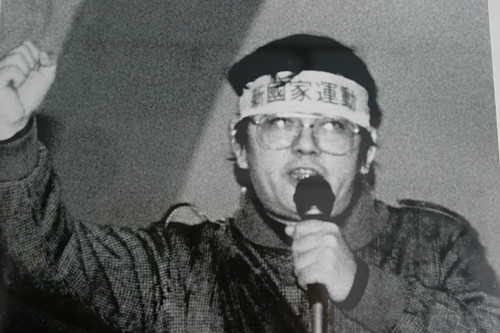

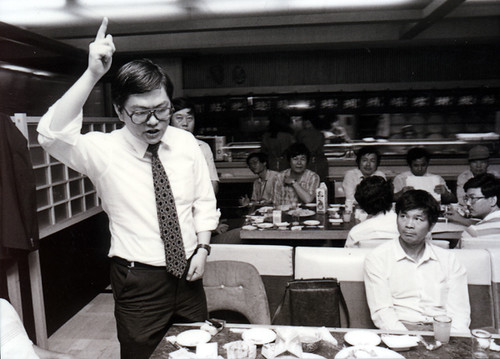
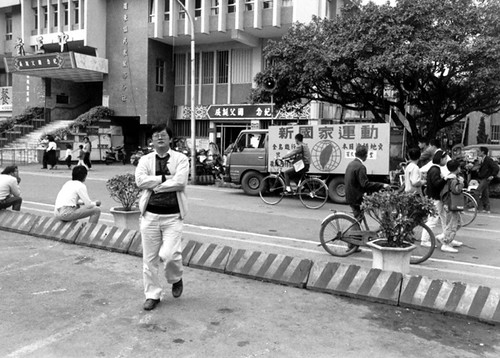

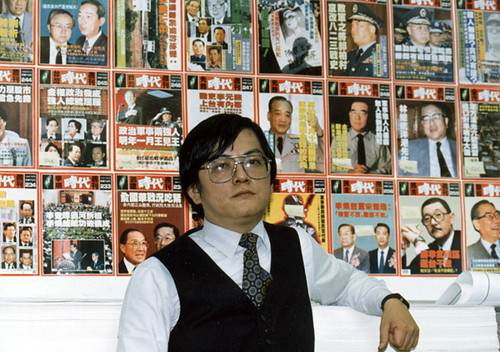
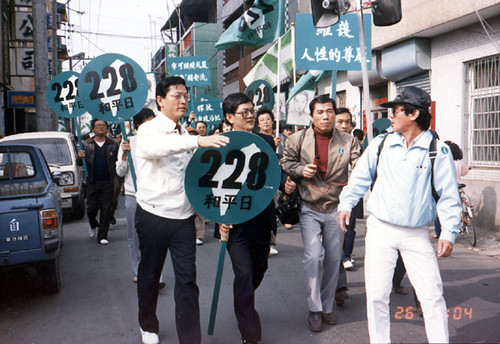
Zheng did not die in vain.
回覆刪除Keep his memory alive.
I too advocate Taiwan independence.
Do you have the reference for the Quote "I'll fight them until teh very end"?
回覆刪除